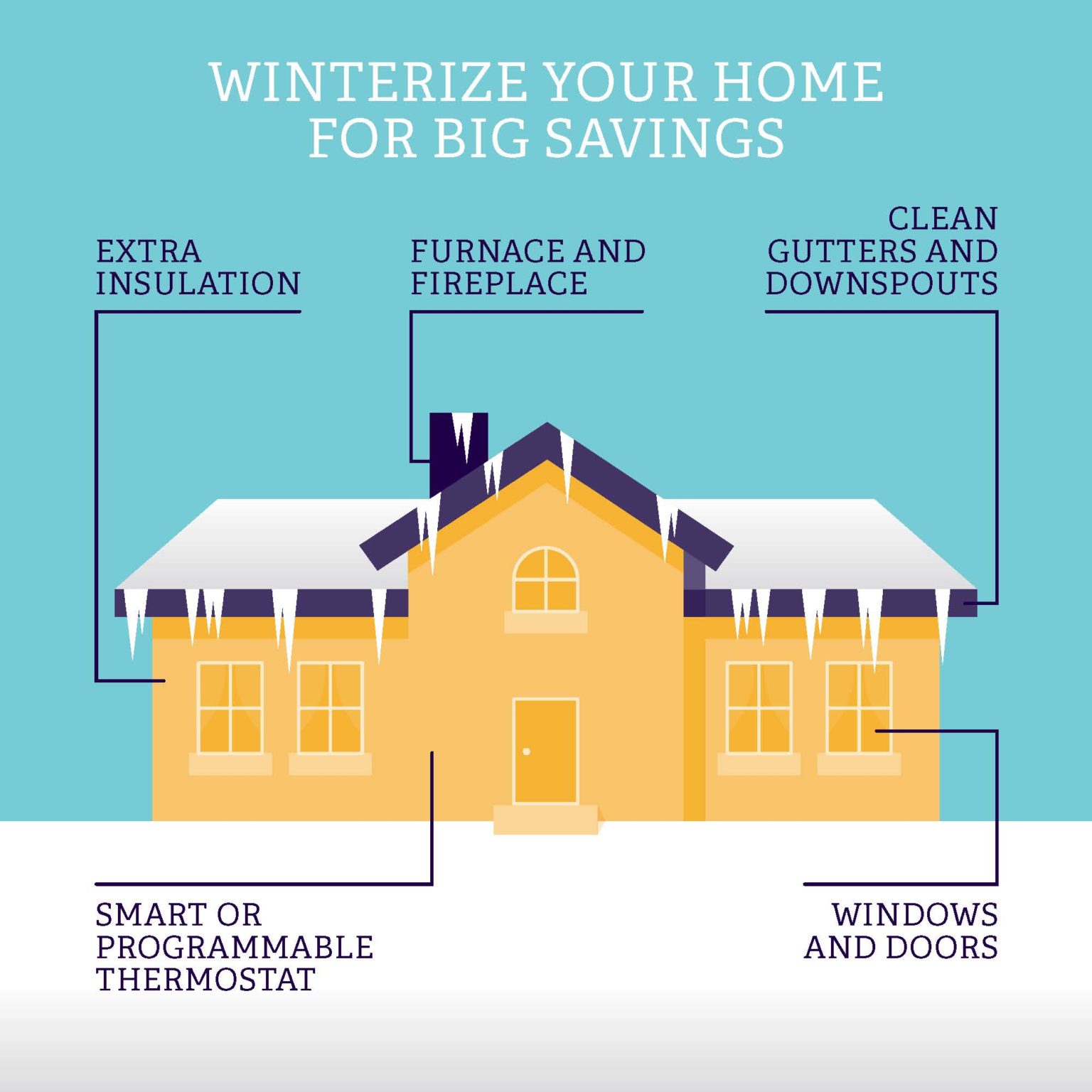Table Of Content

Ensure you wipe your window dry each morning to prevent moisture causing damage to paintwork or leaching into your metal or wooden window frames and causing rust or rot. When doing this, be sure you know how to clean windows without streaks. According to the Buildings Research Establishment, having an open chimney is comparable to leaving a window open all the time. To reduce the effects of this, consider investing in a removable chimney draft excluder, usually made out of felt or wool.

The Power of Landscaping: How to Increase Your Property’s Value with Simple Updates
"Another option is to install pipe heat cables that are thermostat controlled,. Just be aware that you may have to unplug and plug in the cables at the end of this winter and beginning of the next." If you have an attic, making sure it’s properly insulated can help keep your house warm while helping to prevent ice dams. Make sure to check any attic vents for leaks and examine the insulation. You can also have a professional examine the insulation to get a better idea of the shape it’s in. It’s best to do this ahead of the first cold snap so that you have enough time to repair any potential issues. Ice dams, which occur when water builds up behind an ice blockage, can cause damage to ceilings and roofs by allowing melting snow to leak into a home.
Get your fireplace checked out.
If this isn’t properly addressed, moisture build-up could damage your roof deck, insulation and drywall. Learn which pipes are most at risk, and get tips on preventing frozen pipes. With this winterization article, you will be able to cover almost all the things which will help you to save your house from cold weather. In some circumstances, there will be things that are not easy to handle or you were lacking knowledge. If it happens then calling a professional plumber will be the right choice. After a heavy snowfall it is wise to ensure that you have cleared the snow from the parapet and valley gutters.
How to Winterize Your Home in 10 Easy Steps - Redfin Blog
How to Winterize Your Home in 10 Easy Steps.
Posted: Tue, 01 Nov 2022 07:00:00 GMT [source]
Home Insurance Discounts
Just as you want to keep everything inside your home safe, you also want to protect your outdoor items, as well. "You'll need to bring plants and flowering trees inside before the first cold snap," says McCoy. Consider bringing more fragile plants indoors if you live in a colder climate, and remove any annuals you have planted. Put away any outdoor furniture you have, and clear out any fallen leaves so they don’t suffocate the lawn. Finally, store all your gardening tools for the season so they don’t rust or wear down before the spring. You may also want to pull out winter essentials like a snow blower to a more accessible place.
How to Winterize a House for the Cold Weather [Infographic]
Regularly changing your filters is also key for maintaining energy efficiency. Use energy-saver mode where available on your appliances, devices and electronics, and if you’re tempted to turn up the thermostat, consider bundling up with extra layers and blankets first. To keep them from freezing, be sure to completely remove and drain attached garden hoses and store them away for the winter. Another quick and easy winterization item to check off your list is replacing your HVAC filters. “Before your furnace kicks into high gear, install a new HVAC filter so that airflow is not obstructed by any lint or dust build up and can run as efficiently as possible,” Bidwell says. This can keep you more comfortable and help to keep your bill down as well.
Motorcycle insurance is offered by our trusted partner, Dairyland®, through InsuraMatch, LLC, a Travelers-owned insurance agency. We have gathered a list of 10 tips that will help you to winterproof your house perfectly so you can enjoy your winter vacations peacefully. Having graduated with a first class degree in English Literature, Holly started her career as a features writer and sub-editor at Period Living magazine, Homes & Gardens' sister title.
Contact your local independent agent or Travelers representative to make sure your homeowners coverage is up to date and premiums are paid up so you’ll be covered in case anything happens while you’re away. If you’re not sure where it is or how to shut off the water, you should call a professional for help. Usually, there is a single “handle” that you turn to shut off the main. However, as noted, it’s best to call in a professional if you are unsure. Making and checking your plumbing systems all-around your house is a good idea for winterizing your house and for that you may need a professional plumber’s help. Winter cold causes a very serious amount of damage to many homes every year, and while people usually consider these damages unavoidable, there are plenty of ways to prevent them.
How To Winterize Your Home Winter Energy Saving Tips 2022 - Popular Mechanics
How To Winterize Your Home Winter Energy Saving Tips 2022.
Posted: Fri, 19 Nov 2021 08:00:00 GMT [source]
Do you travel to warmer weather during the winter months but often worry about leaving for a long period of time? Read on for tips on protecting your main residence from potential problems so you can relax all season in that sunny vacation spot. Winterizing a home can be a DIY project, but like with many home improvement projects, a professional like a general contractor can do it more quickly and easily. If you decide to prepare your home for winter on your own, allow yourself plenty of time before the cold weather arrives. If you discover any issues that could pose a hazard to yourself or your property, you should call in a professional right away so that you aren’t left out in the cold in your own home this winter. To help avoid wind damage this winter, install wind-proofing features such as permanent window shutters and impact-resistant shingles.
Beyond Costco: 8 Other Places to Buy in Bulk
Only use calcium chloride, not rock salt, which will damage your roof, but be aware that shrubs and plants below the gutters or near downspouts could be damaged by the calcium chloride. When you’re ready to start farming, you’ll also need a farmhouse (3 timber). To avoid missing any essential steps and overspending, create a winterization plan. It is recommended to make a checklist for the tasks that you want to perform while winterizing your home. If not in active use, plug it up with a chimney balloon when winterizing your home to keep drafts out and heat in. You should winterize a house before the first frost – ideally the end of summer into the start of fall.
Make sure first of all that none of your taps is dripping and that they are joined properly. In fall, it is important to take some time to check the health of your windows. Where possible, open them to check their operation, confirming that they shut flush to the frame when closed. Note any drafts; damaged or loose hinges; rotten timber; missing, loose or damaged putty; cracked or peeling paintwork and loose joints. These can all be fixed, though some, such as damaged timber, might need expert assistance. Look for signs of cracking, rot or efflorescence (a sign of damp) – immediately treat these issues with temporary measures to prevent further faults or water ingress.
Attic floors also called loft floors, it itself ventilated and about 10 degrees warmer than the temperature outside. If you have any trees next to your house, check if their branches pose any threat to the roof should they fall off. Half-frozen raindrops can freeze quickly to form thick layers of ice on trees, and their weight can easily cause the branches to break off. If the tree belongs to your neighbor, you should ask them before starting to sculpt it, in order to keep the relations intact.
Outside of cutting down on the winterizing expenses, there are other ways you can keep your bills low in the winter. One obvious one is keeping your thermostat at about 68 degrees, though keeping warm air from escaping through holes and open windows and doors is key, too. If you like bare windows, you might want to reconsider your choices as we head into winter. “When new windows aren’t an option, adding curtains or drapes will help to preserve heat,” DiMartino says. You’ll want to keep them open during the day to allow sunlight to heat your rooms. Another option is to schedule a building pressurization test to be completed by a professional.
If you find any of these gaps, it’s an indication that air can pass through the space, so you’ll need to seal the openings. As an example, you’re likely going to blast your home’s heat source in the winter, but your home should be prepared to retain the hot air. Walk around your house and look for obvious cracks or holes that allow entry to rodent pests. Check places such as around windows and doors, around the fireplace, at the foundation where it meets the ground, around the hot water tank or furnace pipes exiting the house, and dryer vents. It’s not always easy to see a small hole, but you may discover some obvious gaps that can be filled with caulking or foam spray.
If the gutters are not cleaned and are clogged even after the arrival of winter then it will result in overflow and will freeze the ground. To prevent this you can test the gutter and remove clogs messing up inside and install gutter heat tape. Keep the cold out of your home by checking for any cracks and holes in your foundation. Use caulk around windows and foam outlet protectors as a preventative measure. Additionally, implementing rubber or vinyl weather stripping around doors and windows can help insulate areas where cracks let cold air in—or heat is released out. "Replace your door seals, door sweeps, or thresholds to keep cold outside air from seeping into your home," says Cobb.
Be mindful of your safety and use wooden or plastic shovels to help shift the snow. Alternatively, duckboards or electric heating tapes can be provided to keep gutters clear of snow. Snow guards fitted near eaves reduce the risk of snow or ice breaking away and damaging glass in roofs below,’ says Douglas Kent. Identify the entry points of any cold air and then take appropriate steps to control this. Fit brush-style draft excluders to the bottom of doors or invest in a cushion sausage-style excluder to lay in front. Brush-style draft excluders can also be incorporated into letterboxes.












